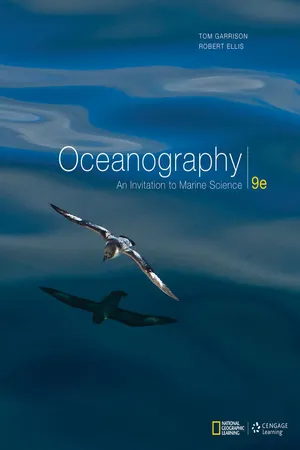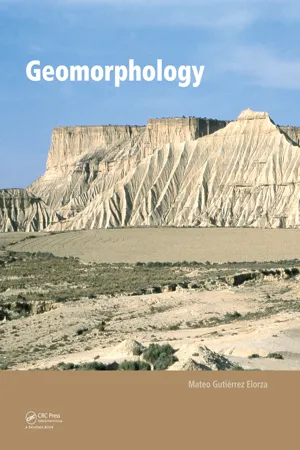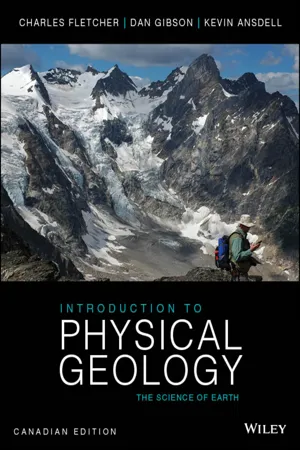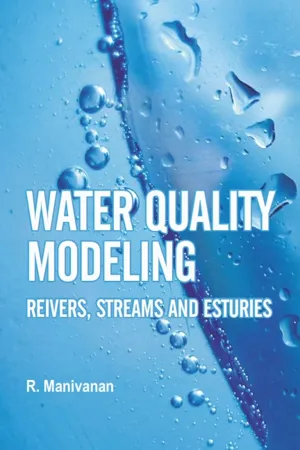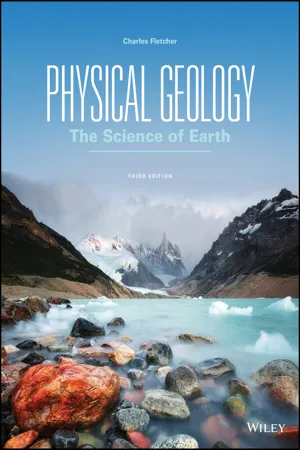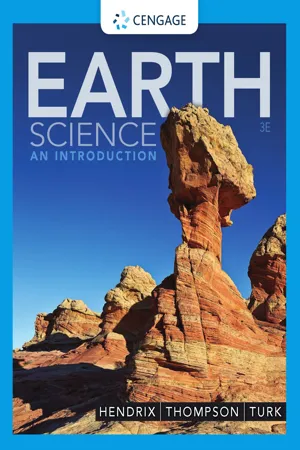Geography
Coastlines
Coastlines refer to the boundary between land and water, where the land meets the sea or ocean. They are dynamic and constantly changing due to natural processes such as erosion, deposition, and tectonic activity. Coastlines are important geographical features that support diverse ecosystems, human settlements, and economic activities.
Written by Perlego with AI-assistance
Related key terms
1 of 5
12 Key excerpts on "Coastlines"
- eBook - PDF
Oceanography
An Invitation to Marine Science
- Tom Garrison(Author)
- 2015(Publication Date)
- Cengage Learning EMEA(Publisher)
Due to electronic rights, some third party content may be suppressed from the eBook and/or eChapter(s). Editorial review has deemed that any suppressed content does not materially affect the overall learning experience. Cengage Learning reserves the right to remove additional content at any time if subsequent rights restrictions require it. CHAPTER 12 336 12.1 Coasts Are Shaped by Marine and Terrestrial Processes Coastal areas join land and sea. Our personal experience with the ocean usually begins at the coast. Have you ever wondered why a coast is in a particular location or why it is shaped as you see it? These temporary, often beautiful junctions of land and sea are subject to rearrangement by waves and tides, by gradual changes in sea level, by biological processes, and by tectonic activity. The place where ocean meets land is usually called the shore , and the term coast refers to the larger zone affected by the processes that occur at this boundary. A sandy beach might form the shore in an area, but the coast (or coastal zone) includes the marshes, sand dunes, and cliffs just inland of the beach, as well as the sandbars and troughs immediately offshore. The world ocean is bounded by about 1,000,000 kilometers (620,000 miles) of shore, about one third of which are sandy beaches (Figure 12.1) . Because of its proximity to both ocean and land, a coast is subject to natural events and processes common to both realms. A coast is an active place. Here is the battleground on which wind waves break and expend their energy. Tides sweep water on and off the rim of land, rivers drop most of their sediments at the coasts, and ocean storms pound the continents. The location of a coast depends primarily on global tectonic activity and the volume of water in the ocean. The shape of a coast is a product of many processes: uplift and subsidence, the wearing down of land by erosion , and the redistribution of material by sediment transport and deposition. - No longer available |Learn more
- James Petersen, Dorothy Sack, Robert Gabler(Authors)
- 2016(Publication Date)
- Cengage Learning EMEA(Publisher)
C H A P T E R 2 0 • C O A S T A L P R O C E S S E S A N D L A N D F O R M S 572 warming significantly reduces the extent of the continental ice sheets, the ensuing rise in sea level will have a profound impact on the human-built infrastructure in coastal regions and on coastal geography and geomorphology. Understanding the natural processes that operate in the coastal zone is fundamental to solving the present and future problems in this dynamic part of Earth’s landscape. The Coastal Zone Most of the processes and landforms of the marine coastal zone are also found along the Coastlines of large lakes. All are consid- ered standing bodies of water because the water in each occupies a basin and has an approximately uniform still-water level around the basin. This contrasts with the sloping, channelized flow toward lower elevations that constitutes streams. The shoreline of a standing body of water is the exact and constantly changing contact between the ocean or lake surface and dry land. The position of this boundary fluctuates with incoming waves, with storms, and, in the case of the ocean, with the tides. Over the long term, the position of the shoreline is also affected by tectonic movements and by the amount of water held in the ocean or lake basin. Sea level is a complexly determined average position of the ocean shoreline and the vertical position (the reference, or datum) above and below which other elevations are measured. The coastal zone consists of the general region of interaction between the land and the ocean or lake. It ranges from the inland limit of coastal influence through the average position of the shoreline to the lowest elevation to which the shoreline fluctuates. As waves approach the mainland from an open body of water, they eventually become unstable and break, sending a rush of water toward land. The nearshore zone extends from the seaward or lakeward edge of breakers to the landward limit reached by the broken wave water (● Fig. 20.1). - eBook - PDF
- Mateo Gutierrez(Author)
- 2012(Publication Date)
- CRC Press(Publisher)
11 COASTAL GEOMORPHOLOGY 1. Introduction 2. Brief history of coastal geomorphology 3. Temporal and spatial scales 4. Sea level variations 5. Waves, currents, and tides 6. Cliff coasts and rocky platforms 7. Coral reef coasts 8. Beaches, barriers, and spits 9. Coastal dunes 10. Mudflats, salt marshes, and mangroves 11. Estuaries and deltas 12. Coastal environments: Uses, management, and risks 11.1 Introduction Bird (2000) defines coastal geomorphology as the study of the evolution of coastal landforms, the processes that affect them, and the changes they undergo. These landforms include cliffs, rocky coastal margins, beaches, dunes, estuaries, lagoons, and deltas. The world’s coastal margins are about 100 m wide and 440,000 km long; humans use them for industrial pur- poses, transportation, and recreation. These human activities profoundly impact these areas. The United Nations estimates that 66% of the world’s population lives within a few kilom- eters of the coast (Pethick, 1984). As a result, food produc- tion, communication, cities, and recreational areas all affect the coast. Coasts have significant problems that include flood- ing, erosion, pollution, and sea level variations that require constant attention. Interdisciplinary studies by coastal engi- neers, oceanographers, and geomorphologists have led to significant advances in coastal management (Stephenson and Brander, 2003). In addition, coasts are constantly changing; the change may be catastrophic or imperceptible. Modifica- tions may occur over decades or centuries but they can also take place in a period of hours or minutes. 11.2 Brief history of coastal geomorphology Prior to the 20th century, research on coastal geomorphology was limited to engineering topics related to coastal erosion (Walker and MacGraw, 2005). Charles Darwin made impor- tant observations on coral reefs and the origin of atolls during his famous voyage on the British ship, the Beagle, in 1835 (Shepard, 1959). - eBook - PDF
- Charles Fletcher, Dan Gibson, Kevin Ansdell(Authors)
- 2014(Publication Date)
- Wiley(Publisher)
592 • CHAPTER 22 Coastal Geology 22-1 Change Is Constantly Occurring on the Shoreline LO 22-1 Identify the many influences on the world’s Coastlines. C oastlines are unique and complex environmental systems influenced by geologic, atmospheric, oceanographic, and biologic processes and materials. As a result, Coastlines are ever-changing environments. In fact, the only constant on Coastlines is change. Because of their temperate climate (air temperature is moderated by heat stored in the ocean) as well as their beautiful vistas and abun- dant resources, coastal lands are the most crowded and developed ar- eas in the world. Fifty percent of the population of the industrialized world lives within 100 km of a coast, a population that will grow by 15 percent during the next two decades. In the United States, over 37 million people and 19 million homes were added to coastal areas over the last three decades. This narrow fringe—comprising less than one- fifth of the contiguous land area of the United States—accounts for over half the nation’s population and housing supply. Yet coasts are subject to destructive storms and tsunamis (FIGURE 22.1) that sweep inland from the sea, as well as to coastal erosion that slowly eats away at beaches and cliffs and to accelerat- ing sea-level rise due to global warming. Development pressure on coasts has led to pollution of coastal water bodies, depletion of coastal fisheries, and changes in sedimentary processes that support vital ecosystems. With so much of our culture and economy focused on the shore- line, geologists need to play an active role in advancing the scientific understanding of coastal environments and providing scientific data that can be used to improve management plans and programs. As a result, in recent decades, the new field of coastal geology has emerged. - eBook - PDF
Water Quality Modeling
Rivers, Streams and Estuaries
- R. Manivanan(Author)
- 2021(Publication Date)
- 93 - 7.1 Introduction The coast is one of the most important boundaries in the world. It separates the marine part of the world from the continents. It separates the salt-water communities from fresh water communities; it separates land life from water borne life but amphibians living both environments (Fig. 7.1). Some of the marine organisms move towards estuary for reproduction with less water salinity. The coastline as such is not a stable. It fluctuates in place over considerable distances due to erosion and sedimentation, but also due to the relative change of sea level with respect to land. The coastal zone is thus a very mobile part of the earth from a geographical point of view. Due to its specific geophysical properties, the coast is also a very important area for the development of flora and fauna. There is hardly any other part of the world that houses such a variety of species, both in flora and fauna. The abundance of opportunities along the coast has also attracted a lot of human activities. The coastal zone has become an indispensable resource for mankind. It provides excellent opportunities for fisheries, housing, recreation, transport, defense purpose, industrial activities and many others. The influx of man with their social and economic Chapter 7 Modeling: Coastal and Estuaries 94 WATER QUALITY MODELING activities, their needs for safe housing, food, drinking water, and with the tremendous quantities of waste they are producing poses at the same time a serious threat to the unique features of the coastal zone. It is therefore necessary to study this valuable region so as to prevent that competing activities are gradually causing depletion of the resources in the coastline. The following figures (Fig. 7.1and 7.2) show the typical coastal area of rocky coast and sandy coast. - eBook - PDF
Physical Geology
The Science of Earth
- Charles Fletcher(Author)
- 2017(Publication Date)
- Wiley(Publisher)
With so much of our culture and economy focused today on the shoreline, it is essential that geologists advance the scientific understanding of coastal environments and provide reliable data that can be applied to improving management plans and programs. To that end, in recent decades a new field of study, coastal geology, has emerged. Coastal geology is concerned with understanding coastal processes (such as how waves and currents move sediment), the geologic history of coastal areas, and how humans live in coastal environments (Figure 20.2). Shorelines Are in a State of Perpetual Change 615 FIGURE 20.2 Trash like this washes up on beaches around the world because humans have been polluting the ocean for decades. Peter Chadwick/Getty Images, Inc. What are the potential consequences of dumping garbage in the ocean? Coastal Processes Sediments in the coastal zone may come from watersheds (typ- ically, siliciclastic grains) as well as from the ocean (typically, calcium carbonate). Winds, waves, and currents transport and deposit these sediments, thereby shaping various coastal environments—beaches, estuaries, deltas, wetlands, and reefs. Since the last ice age, a rising global sea level (over 120 meters) has flooded river mouths, drowned low-lying coastal lands, and shifted the coastline landward, in many cases over hundreds of kilometers. Winds, waves, tides, sea level change, and currents act as agents of change, collectively called coastal processes. They sculpt the shoreline through erosion and deposition of sedi- ment and by flooding low areas. Understanding how coastal processes and sedimentary materials interact is crucial to inter- preting the geologic history of coastal systems and finding ways for people to live in the coastal zone in a sustainable manner. Coastal Terminology Scientists employ a number of specific terms when describing the coastal zone. - eBook - PDF
Rediscovering the Golden State
California Geography
- William A. Selby(Author)
- 2018(Publication Date)
- Wiley(Publisher)
An inter- face where land, atmosphere, fresh water, and ocean meet, the coastal strip is an ideal place to recognize profound connections between natural and human processes that are shaping California. From coastal bluffs covered with forests to delicate sand dunes, from wide sandy beaches to some of the most modern and dense human developments, the California coast displays excellent examples of the importance of the themes that run throughout this book— connections, diversity, and change. These shorelines may appear—as backdrop, setting, or star—in more films than any other landscapes on our planet. It is no surprise that most Californians and visitors consider the state’s shorelines unequaled and irreplaceable jewels. These are perfect settings for us to apply geography to better examine and solve problems. Coastal Geomorphology Such a fascinating story must begin with cycles of matter and energy that have shaped the coast for thousands of years. Internal (endogenic), mountain-building forces have folded and faulted coastal landscapes above the sea. There are countless examples of dramatic, steep land- scapes that result when mountains are lifted vertically out of the ocean; you will find them from the Oregon border to the northern Coast Ranges’ King Range to Big Sur’s Santa Lucia Range, and from Point Conception to the Mexican border. No doubt, these modern events and landscapes are evidence of enduring processes that have gradually, for millions of years, lifted California out of the water, from the east to the west. Rather than falling into the sea, most coastal Californians are gradually ris- ing above it. External mass wasting processes deliver many of the steeper slopes directly back into the ocean, where waves can reshape and carry the debris out to quieter waters or other distance shorelines. Rocky coasts, bluffs, and cliffs are left behind to precariously dangle until the next land- slide. - eBook - PDF
- Alan F. Arbogast(Author)
- 2017(Publication Date)
- Wiley(Publisher)
Geographers were involved in mapping the extent of the spill and the coastal zones that were potentially harmed. This sec- tion will discuss some of the ways humans impact Coastlines. Coastal Engineering One of the most obvious ways that people impact the coastline is through engineered structures. Although these structures come in a wide variety of forms, they are generally built with the idea of (1) protecting the shore and shorefront homes from coastal hazards such as erosion and storm surges, (2) stabi- lizing and nourishing beaches, or (3) maintaining or improving the flow of trade or traffic into ports. Shoreline Protection Of the many people who live near U.S. Coastlines, a large number choose to reside or work directly on the shore (Figure 19.35). The reasons for this choice are probably obvious, as the shore is a pleasurable landscape in which to live and work, with spectacular views and numerous Human Interactions with Coastlines 459 recreational opportunities. However, Coastlines are one of the more sensitive landscapes on Earth, with changes occur- ring on a daily basis and major adjustments taking place when strong storms such as hurricanes strike. Although extreme events such as hurricanes are indeed dangerous, they are statistically rare along any particular stretch of coast. As a result, people tend to be much more concerned about the erosion associated with less severe storms, waves, and high-water level. Unchecked, the effects of shoreline erosion on coastal communities can be disastrous (Figure 19.36). In an effort to control these effects, people have devised a variety of protective structures. Perhaps the most common way people attempt to mitigate coastal erosion is to build sea walls and revetments that armor the shore. As the name implies, a sea wall is a vertical, wall-like structure built along the coast, usually at the landward edge of a beach, where a bluff or dune may occur. Figure 19.37 shows a sea wall at Palm Beach, Florida. - eBook - ePub
- Simon K. Haslett(Author)
- 2016(Publication Date)
- University of Wales Press(Publisher)
section 1.1.1 is very much for the use of physical scientists studying the coast. However, for planning and management purposes, where administration is involved, the coastal zone is much more variably defined. Kay and Alder (2005) give a range of definitions used by various organisations in international and national government. Some definitions are known as distance definitions, whether fixed or variable, where the coastal zone is defined as being so many kilometres landward, and so many nautical miles seaward, of the shoreline. Other definitions do attempt to recognise and incorporate aspects of the working complexity of the coastal zone. In abbreviated form, these include:- ‘the coastal waters and the adjacent shorelands strongly influenced by each other, and includes islands, transitional and intertidal areas, salt marshes, wetlands and beaches. The zone extends inland from the shorelines only to the extent necessary to control shorelands, the uses of which have a direct and significant impact on the coastal waters’ (United States Federal Coastal Zone Management Act)
- ‘as far inland and as far seaward as necessary to achieve the Coastal Policy objectives, with a primary focus on the land-sea interface’ (Australian Commonwealth Coastal Policy)
- ‘definitions may vary from area to area and from issue to issue, and that a pragmatic approach must therefore be taken’ (United Kingdom Government Environment Committee)
- ‘the special area, endowed with special characteristics, of which the boundaries are often determined by the special problems to be tackled’ (World Bank Environment Department).
Coasts are not static environments and are in fact highly dynamic, with erosion, sediment transport and deposition all contributing to the continuous physical change that characterises the coast. Such dynamism requires energy to drive the coastal processes that bring about physical change, and all coasts are the product of a combination of two main categories of processes driven by different energy sources (Fig. 1.1 ):- The first category of processes is known as theendogenetic processes, so-called because their origin is from within the earth. Endogenetic processes are driven by geothermal energy which emanates from the earth’s interior as a product of the general cooling of the earth from its originally hot state, and from radioactive material, which produces heat when it decays. The flux of geothermal energy from the earth’s interior to the surface is responsible for driving continental drift and is the energy source in the plate tectonics theory. Its influence on the earth’s surface, and the coast is no exception, is to generally raiserelief
- eBook - PDF
Earth Science
An Introduction
- Mark Hendrix, Graham Thompson, Mark Hendrix(Authors)
- 2020(Publication Date)
- Cengage Learning EMEA(Publisher)
Irregular Coastlines are straightened by erosion and deposition. • If land rises or sea level falls, the coastline migrates seaward and old beaches are abandoned above sea level, forming an emergent coastline. In contrast, a submergent coastline forms when land sinks or sea level rises. • A beach is a strip of shoreline washed by waves and tides. Most coastal sediment is transported to the sea by rivers. Glacial drift, reefs, and local erosion also add sand in certain areas. Coastal emergence may expose large amounts of sand. Spits, baymouth bars, and barrier islands are common on sandy Coastlines. Human intervention such as the building of groins may upset the natural movement of coastal sediment and alter patterns of erosion and deposition on beaches. A rocky coast is dominated by wave-cut cliffs, wave-cut platforms, sea arches, and sea stacks. A fjord is a steep-sided, narrow, glacially carved, submerged valley on a high-latitude seacoast. • Most of the photosynthesis and nutrient consumption in the ocean is carried out by plankton, tiny organisms that live mostly within a few meters of the sea surface where light is available. Phytoplankton conduct photosynthesis, just as land-based plants do, and are the base of the food chain for aquatic animals. Zooplankton are tiny animals that feed on the phytoplankton. The shallow water of a continental shelf supports large populations of marine organisms. Commercial overfishing and habitat destruction threaten world fish harvests. A reef is a wave-resistant ridge or mound built by corals, oysters, algae, or other organisms. • Ocean water expands when it warms, and when glaciers melt large volumes of water flow into the sea—both mechanisms cause global sea-level to rise. Global sea level has risen over the past century and may continue into the next. Many poor countries cannot afford coastal protection for even a small sea-level rise; a dramatic sea-level rise could inundate coastal cities. - eBook - PDF
- James Petersen, Dorothy Sack, Robert Gabler, , James Petersen, James Petersen, Dorothy Sack, Robert Gabler(Authors)
- 2021(Publication Date)
- Cengage Learning EMEA(Publisher)
Some Coastlines, such as those composed of river deltas, can- not be classified as either submerging or emerging. Actually, most shorelines show evidence of more than one type of development largely because the land elevation and the level of the ocean have ● FIGURE 20.28 Cape Blanco, Oregon, represents an emergent coastline. The flat surface on which the lighthouse is built is a marine terrace formed by wave erosion and deposition prior to tectonic uplift. The elevation of the marine terrace is about 61 meters (200 ft) above sea level. ● FIGURE 20.29 Submergent coasts like the Chesapeake Bay region are characterized by drowned river valleys, known as rias, that developed as sea level rose at the end of the Pleistocene. ● FIGURE 20.30 Fjords, like this one in Greenland, are glaciated valleys that were drowned by the sea following the Pleistocene Epoch as the glaciers receded and sea level rose. USGS NASA Matt Ebiner Copyright 2022 Cengage Learning. All Rights Reserved. May not be copied, scanned, or duplicated, in whole or in part. Due to electronic rights, some third party content may be suppressed from the eBook and/or eChapter(s). Editorial review has deemed that any suppressed content does not materially affect the overall learning experience. Cengage Learning reserves the right to remove additional content at any time if subsequent rights restrictions require it. 594 C H A P T E R 2 0 • C O A S T A L P R O C E S S E S A N D L A N D F O R M S changed many times during geologic history. For this reason, features of both submerged and emerged shorelines characterize some coastal areas. Because both continental and marine geomorphic processes shape Coastlines, another regional classification system recog- nizes two types of coasts: primary and secondary Coastlines. Ero- sion and depositional processes of the land dominate primary Coastlines. - eBook - PDF
- Tom Garrison, Robert Ellis(Authors)
- 2017(Publication Date)
- Cengage Learning EMEA(Publisher)
Coastal environments have been evolving for millions of years and we should not presume to be able to stop that. If we continue to do so, scenes like the one shown in Figure 8.29 will likely become more common. Let’s enjoy them in their present stages. Copyright 2018 Cengage Learning. All Rights Reserved. May not be copied, scanned, or duplicated, in whole or in part. WCN 02-300 CHAPTER 8 174 TERMS AND CONCEPTS TO REMEMBER backshore backwash barrier island bay bay mouth bar beach beach nourishment beach scarp berm berm crest breakwater coast coral reef delta depositional coast erosion erosional coast estuary eustatic change fjord fjord estuary foreshore groin headlands high-energy coast inlet jetty lagoon longshore bar longshore current longshore drift longshore trough low-energy coast mangrove marine terrace partially mixed estuary salt wedge estuary sand spit sandbar sea arch sea cave sea cliff sea island sea stack shore swash tombolo wave-cut platform well-mixed estuary In this chapter you learned that the location of a coast depends primarily on global tectonic activity and the ocean’s water volume, whereas the shape of a coast is a product of many processes: uplift and subsidence, the wearing down of land by erosion, and the redis-tribution of material by sediment transport and deposition. Coasts are classified as erosional coasts (on which erosion dominates) or depositional coasts (on which deposition dominates). Natural rock bridges, tall stacks, and sea caves are found on erosional coasts. Depositional coasts often support beaches, accumulations of loose particles. Generally, the finer the particles on the beach, the flatter Chapter in Perspective its slope. Beaches change shape and volume as a function of wave energy and the balance of sediment input and removal. Deltas and estuaries form where freshwater meets the ocean. Coral reefs and mangroves are among the most complex and biologically productive coasts.
Index pages curate the most relevant extracts from our library of academic textbooks. They’ve been created using an in-house natural language model (NLM), each adding context and meaning to key research topics.
